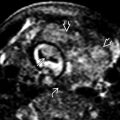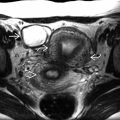KEY FACTS
Terminology
- •
Newborn with birth weight > 4,000 or 4,500 g (10 lb)
- •
Fetus is considered at risk for macrosomia if estimated fetal weight (EFW) is > 90th percentile
Imaging
- •
Large abdominal circumference (AC) is 1st clue
- ○
AC is heavily weighted in all EFW calculations
- ○
- •
Unfortunately, fetal weight prediction is not very accurate
- ○
High false-positive rates for macrosomia
- –
Only 1/2 of newborns predicted to weigh > 4,500 g will actually weigh > 4,500 g
- –
- ○
High negative predictive value of 97-99% is reassuring
- –
EFW < 90th percentile is usually predictive that newborn will not be macrosomic
- –
- ○
Growth graphs are useful visual tools
- ○
- •
Associated findings
- ○
Polyhydramnios
- ○
↑ subcutaneous adipose tissue
- ○
Top Differential Diagnoses
- •
Beckwith-Wiedemann syndrome: Large tongue, liver, spleen, kidneys
- •
Hydrops: Skin edema, pleural effusion, ascites
Clinical Issues
- •
Associated with maternal diabetes
- •
Maternal complications: Prolonged, arrested labor
- •
Fetal complications: Shoulder dystocia, hypoglycemia, hypocalcemia
- •
Cesarean delivery recommended if EFW > 5,000 g and patient is not diabetic
- •
Cesarean delivery recommended if EFW > 4,500 g and patient is diabetic
Scanning Tips
- •
Perform several AC measurements and average good ones
- •
Macrosomia is critical finding, just like fetal growth restriction (need to alert referring clinician)
 .
.










